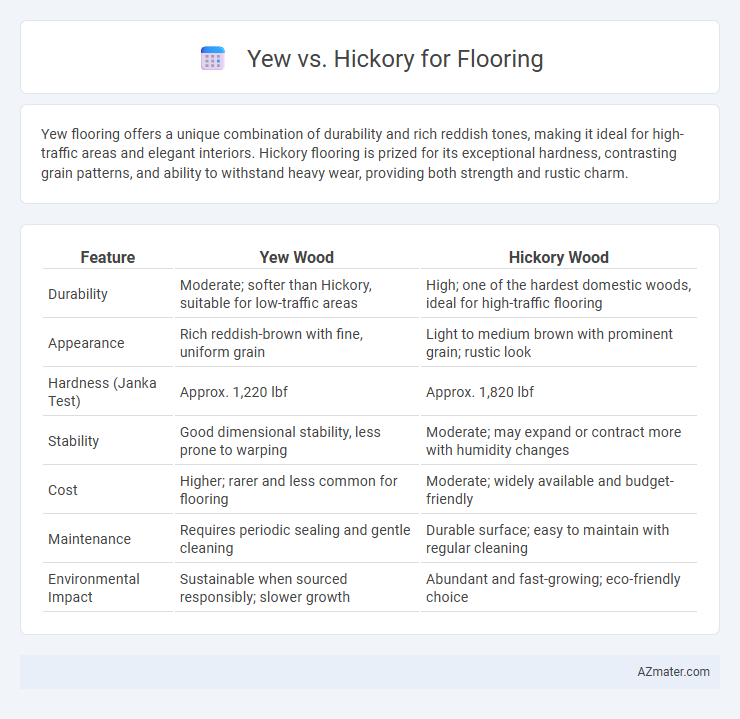Yew flooring offers a unique combination of durability and rich reddish tones, making it ideal for high-traffic areas and elegant interiors. Hickory flooring is prized for its exceptional hardness, contrasting grain patterns, and ability to withstand heavy wear, providing both strength and rustic charm.
Table of Comparison
| Feature | Yew Wood | Hickory Wood |
|---|---|---|
| Durability | Moderate; softer than Hickory, suitable for low-traffic areas | High; one of the hardest domestic woods, ideal for high-traffic flooring |
| Appearance | Rich reddish-brown with fine, uniform grain | Light to medium brown with prominent grain; rustic look |
| Hardness (Janka Test) | Approx. 1,220 lbf | Approx. 1,820 lbf |
| Stability | Good dimensional stability, less prone to warping | Moderate; may expand or contract more with humidity changes |
| Cost | Higher; rarer and less common for flooring | Moderate; widely available and budget-friendly |
| Maintenance | Requires periodic sealing and gentle cleaning | Durable surface; easy to maintain with regular cleaning |
| Environmental Impact | Sustainable when sourced responsibly; slower growth | Abundant and fast-growing; eco-friendly choice |
Introduction to Yew and Hickory Flooring
Yew flooring offers a unique blend of durability and rich reddish-brown hues, making it an attractive choice for high-end interiors. Hickory flooring is renowned for its exceptional hardness and striking grain patterns, providing both strength and visual interest in rustic or contemporary settings. Both woods deliver long-lasting performance but differ significantly in color, grain texture, and wear resistance.
Appearance and Grain Patterns
Yew flooring showcases a warm, honey-yellow hue with subtle reddish undertones, featuring straight grain patterns interspersed with occasional knots that add character and a rustic appeal. Hickory flooring is known for its striking contrast, displaying a wide range of colors from light cream to rich brown, with highly pronounced, wavy, and irregular grain patterns that create a bold and dynamic look. The distinctively varied appearance of Hickory offers a more dramatic and textured aesthetic compared to the smoother, more uniform patterns of Yew, making them ideal for different design preferences.
Durability and Hardness Comparison
Yew flooring offers a unique combination of moderate hardness with a Janka rating around 1,200, making it less resistant to dents and wear compared to Hickory, which boasts a much higher Janka hardness rating of approximately 1,820. Hickory's superior durability ensures better performance in high-traffic areas due to its dense grain structure and resistance to impact and scratches. While Yew provides aesthetic value with its rich color and fine texture, Hickory remains the preferred choice for flooring applications demanding longevity and toughness.
Cost and Affordability
Yew flooring typically costs between $8 to $12 per square foot, offering moderate affordability compared to other exotic hardwoods, while Hickory ranges from $6 to $9 per square foot, making it a more budget-friendly option for durable, high-quality flooring. Hickory's cost-effectiveness is enhanced by its widespread availability and robust hardness rating of 1,820 on the Janka scale, which balances price with longevity. Yew, being less common and softer with a Janka rating around 950, may incur additional maintenance costs, influencing its overall affordability in flooring projects.
Installation Process and Challenges
Yew flooring requires precise acclimatization and careful handling due to its dense grain and natural oils, which can complicate adhesive bonding and finishing during installation. Hickory's hardness demands robust tools and skilled craftsmanship to achieve tight seams and smooth surfaces, often extending the installation timeline and increasing labor costs. Both woods necessitate proper subfloor preparation and moisture control to prevent warping and ensure long-term durability.
Maintenance and Longevity
Yew flooring offers moderate maintenance with occasional refinishing needed due to its softer wood grain, making it more prone to dents and scratches compared to hickory. Hickory flooring is renowned for its exceptional durability and resistance to wear, requiring less frequent upkeep and offering superior longevity in high-traffic areas. Choosing hickory ensures long-term performance and easier maintenance, while yew may require more careful handling to preserve its appearance over time.
Environmental Impact and Sustainability
Yew flooring offers a sustainable option due to its slow growth and ability to regenerate without extensive deforestation, promoting biodiversity in managed forests. Hickory is highly durable and long-lasting, reducing the need for frequent replacements, but its environmental impact varies depending on harvesting practices and the region of origin, with some sources linked to deforestation. Choosing FSC-certified yew or hickory wood ensures responsible forestry management, minimizing ecological damage and supporting sustainable flooring solutions.
Suitability for High-Traffic Areas
Hickory flooring is highly suitable for high-traffic areas due to its exceptional hardness and resistance to wear, ranking around 1820 on the Janka hardness scale. Yew, while aesthetically appealing, has a lower Janka rating of approximately 1010, making it less durable under heavy foot traffic. For commercial spaces or busy households, hickory offers superior performance and longevity, maintaining its structural integrity and appearance over time.
Popular Design Styles and Applications
Yew flooring offers a warm, rich appearance with fine grain patterns ideal for traditional and rustic design styles, often used in living rooms and custom cabinetry. Hickory flooring features a strong contrasting grain and high durability, making it popular for farmhouse, industrial, and transitional interiors, suitable for high-traffic areas like kitchens and hallways. Both woods provide unique aesthetic appeal, with yew enhancing cozy, classic spaces and hickory supporting bold, modern rustic designs.
Final Verdict: Which is Best for Your Home?
Yew flooring offers a unique, rich color palette and natural durability ideal for low-traffic areas, while Hickory provides superior hardness and resistance to dents, making it better suited for high-traffic spaces and homes with pets or children. The dense grain and shock resistance of Hickory ensure long-lasting performance, whereas Yew's aesthetic appeal caters to homeowners prioritizing elegance and distinctiveness. For practical everyday use with robust wear tolerance, Hickory stands as the best choice, but for showcasing natural beauty and character, Yew remains an excellent option.

Infographic: Yew vs Hickory for Flooring
 azmater.com
azmater.com